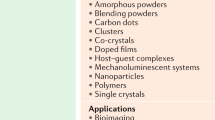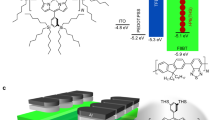Abstract
The control of the emission properties of synthetic organic molecules through molecular design has led to the development of high-performance optoelectronic devices with tunable emission colours, high quantum efficiencies and efficient energy/charge transfer processes1,2,3,4. However, the task of generating excited states with long lifetimes has been met with limited success, owing to the ultrafast deactivation of the highly active excited states5. Here, we present a design rule that can be used to tune the emission lifetime of a wide range of luminescent organic molecules, based on effective stabilization of triplet excited states through strong coupling in H-aggregated molecules. Our experimental data revealed that luminescence lifetimes up to 1.35 s, which are several orders of magnitude longer than those of conventional organic fluorophores6,7, can be realized under ambient conditions. These results outline a fundamental principle to design organic molecules with extended lifetimes of excited states, providing a major step forward in expanding the scope of organic phosphorescence applications.
This is a preview of subscription content, access via your institution
Access options
Subscribe to this journal
Receive 12 print issues and online access
$259.00 per year
only $21.58 per issue
Buy this article
- Purchase on Springer Link
- Instant access to full article PDF
Prices may be subject to local taxes which are calculated during checkout




Similar content being viewed by others
References
Bendikov, M., Wudl, F. & Perepichka, D. F. Tetrathiafulvalenes, oligoacenenes, and their buckminsterfullerene derivatives: The brick and mortar of organic electronics. Chem. Rev. 104, 4891–4946 (2004).
Uoyama, H. et al. Highly efficient organic light-emitting diodes from delayed fluorescence. Nature 492, 234–238 (2012).
Samuel, I. D. W. & Turnbull, G. A. Organic semiconductor lasers. Chem. Rev. 107, 1272–1295 (2007).
Yap, B. K. et al. Simultaneous optimization of charge-carrier mobility and optical gain in semiconducting polymer films. Nature Mater. 7, 376–380 (2008).
Vura-Weis, J. et al. Crossover from single-step tunneling to multistep hopping for molecular triplet energy transfer. Science 328, 1547–1550 (2010).
Baldo, M. A. et al. Highly efficient phosphorescent emission from organic electroluminescent devices. Nature 395, 151–154 (1998).
Lakowicz, J. R. Principles of Fluorescence Spectroscopy (Springer, 2006).
Bakulin, A. A. et al. The role of driving energy and delocalized states for charge separation in organic semiconductors. Science 335, 1340–1344 (2012).
Xing, G. C. et al. Long-range balanced electron- and hole-transport lengths in organic–inorganic CH3NH3PbI3 . Science 342, 344–347 (2013).
Garcia-Garibay, M. A. Advances at the frontiers of photochemical sciences. J. Am. Chem. Soc. 134, 8289–8292 (2012).
Cheng, G. et al. Color tunable organic light-emitting devices with external quantum efficiency over 20% based on strongly luminescent gold(III) complexes having long-lived emissive excited states. Adv. Mater. 26, 2540–2546 (2014).
Zhao, J., Wu, W., Sun, J. & Guo, S. Triplet photosensitizers: From molecular design to applications. Chem. Soc. Rev. 42, 5323–5351 (2013).
Maldiney, T. et al. Controlling electron trap depth to enhance optical properties of persistent luminescence nanoparticles for in vivo imaging. J. Am. Chem. Soc. 133, 11810–11815 (2011).
Van den Eeckhout, K., Smet, P. F. & Poelman, D. Persistent luminescence in Eu2+-doped compounds: A review. Materials 3, 2536–2566 (2010).
Pan, Z. W., Lu, Y. Y. & Liu, F. Sunlight-activated long-persistent luminescence in the near-infrared from Cr3+-doped zinc gallogermanates. Nature Mater. 11, 58–63 (2012).
Kohler, A. & Bassler, H. Triplet states in organic semiconductors. Mater. Sci. Eng. R 66, 71–109 (2009).
Xu, H. et al. Recent progress in metal-organic complexes for optoelectronic applications. Chem. Soc. Rev. 43, 3259–3302 (2014).
Bolton, O. et al. Activating efficient phosphorescence from purely organic materials by crystal design. Nature Chem. 3, 205–210 (2011).
Hirata, S. et al. Efficient persistent room temperature phosphorescence in organic amorphous materials under ambient conditions. Adv. Funct. Mater. 23, 3386–3397 (2013).
Menning, S. et al. Twisted tethered tolanes: Unanticipated long-lived phosphorescence at 77 K. J. Am. Chem. Soc. 135, 2160–2163 (2013).
Wang, J. et al. Enhancing multiphoton upconversion through energy clustering at sublattice level. Nature Mater. 13, 157–162 (2014).
Meinardi, F. et al. Superradiance in molecular H-aggregates. Phys. Rev. Lett. 91, 10958–10966 (2003).
Chaudhuri, D. et al. Enhancing long-range exciton guiding in molecular nanowires by H-aggregation lifetime engineering. Nano Lett. 11, 488–492 (2011).
Petersilka, M., Gossmann, U. J. & Gross, E. K. U. Excitation energies from time-density functional theory. Phys. Rev. Lett. 76, 1212–1215 (1996).
Beljonne, D., Shuai, Z., Pourtois, G. & Bredas, J. L. Spin–orbit coupling and intersystem crossing in conjugated polymers: A configuration interaction description. J. Phys. Chem. A 105, 3899–3907 (2001).
Ma, J., Chen, J. Y., Idowu, M. & Nyokong, T. Generation of singlet oxygen via the composites of water-soluble thiol-capped CdTe quantum dots sulfonated aluminum phthalocyanines. J. Phys. Chem. B 112, 4465–4474 (2008).
Kasha, M., Rawls, H. R. & El-Bayoumi, M. A. The exciton model in molecular spectroscopy. Pure Appl. Chem. 11, 371–392 (1965).
Lower, S. K. & El-Sayed, M. A. The triplet state and molecular electronic processes in organic molecules. Chem. Rev. 66, 199–241 (1966).
Congreve, D. N. et al. External quantum efficiency above 100% in singlet-exciton-fission-based organic photovoltaic cell. Science 340, 334–337 (2013).
Zhao, Y. & Truhlar, D. G. The M06 suite of density functionals for main group thermochemistry, thermochemical kinetics, noncovalent interactions, excited states, and transition elements: Two new functionals and systematic testing of four M06-class functionals and 12 other functionals. Theor. Chem. Acc. 120, 215–241 (2008).
Fennel, F. et al. Biphasic self-assembly pathways and size-dependent photophysical properties of perylene bisimide dye aggregate. J. Am. Chem. Soc. 135, 18722–18725 (2013).
Forrest, S. R. The path to ubiquitous and low-cost organic electronic appliances on plastic. Nature 428, 911–918 (2004).
Acknowledgements
We thank Y. Wang, W. Zeng, T. Tsuboi, C. Zhang and G. Xing for technical assistance. This study was supported by the National Natural Science Foundation of China (grant No. 21274065, 21304049, 61136003 and 51173081), the Ministry of Education of China (grant No. IRT1148), a project funded by the priority academic program development of Jiangsu higher education institutions (PAPD, YX03001), the Qing Lan project of Jiangsu province, the Singapore Ministry of Education (MOE2010-T2-1-083), Natural Science Foundation of Jiangsu Province of China (BM2012010) and the National Basic Research Program of China (973 Program) (2012CB933301, 2012CB723402, 2015CB932200 and 2014CB648300).
Author information
Authors and Affiliations
Contributions
Z.A., C.Z., Y.T., R.C., X.L. and W.H. conceived the experiments. R.C., X.L. and W.H. prepared the paper. Z.A., C.Z., Y.T. and H.S. were primarily responsible for the experiments. R.D., Z.W. and H.L. performed the lifetime measurements. T.C. contributed to TD-DFT calculations. All authors contributed to the data analyses.
Corresponding authors
Ethics declarations
Competing interests
The authors declare no competing financial interests.
Supplementary information
Supplementary Information
Supplementary Information (PDF 4214 kb)
Supplementary Information
Supplementary Movie 1 (MP4 19445 kb)
Supplementary Information
Supplementary Movie 2 (MP4 6333 kb)
Supplementary Information
Supplementary Movie 3 (MP4 6394 kb)
Supplementary Information
Supplementary Movie 4 (MP4 3421 kb)
Rights and permissions
About this article
Cite this article
An, Z., Zheng, C., Tao, Y. et al. Stabilizing triplet excited states for ultralong organic phosphorescence. Nature Mater 14, 685–690 (2015). https://doi.org/10.1038/nmat4259
Received:
Accepted:
Published:
Issue Date:
DOI: https://doi.org/10.1038/nmat4259
This article is cited by
-
Dual-channel mechano-phosphorescence: a combined locking effect with twisted molecular structures and robust interactions
Light: Science & Applications (2024)
-
Photocured room temperature phosphorescent materials from lignosulfonate
Nature Communications (2024)
-
Charge trapping for controllable persistent luminescence in organics
Nature Photonics (2024)
-
Halogenated Thienoacene Derivatives with Improved Emission Properties
Chemical Research in Chinese Universities (2024)
-
D-O-A based organic phosphors for both aggregation-induced electrophosphorescence and host-free sensitization
Nature Communications (2023)



